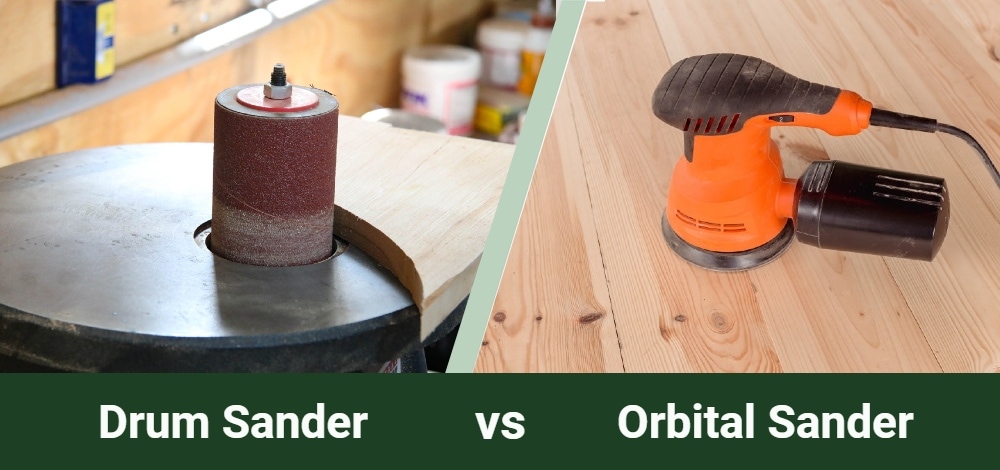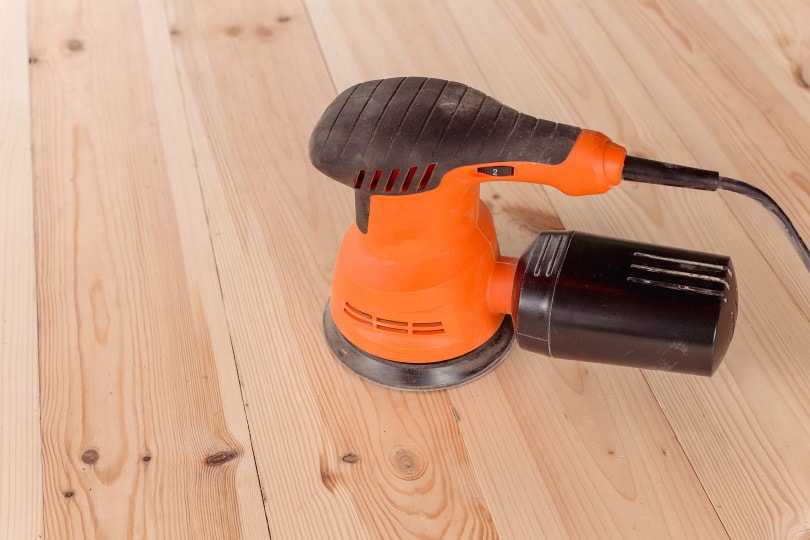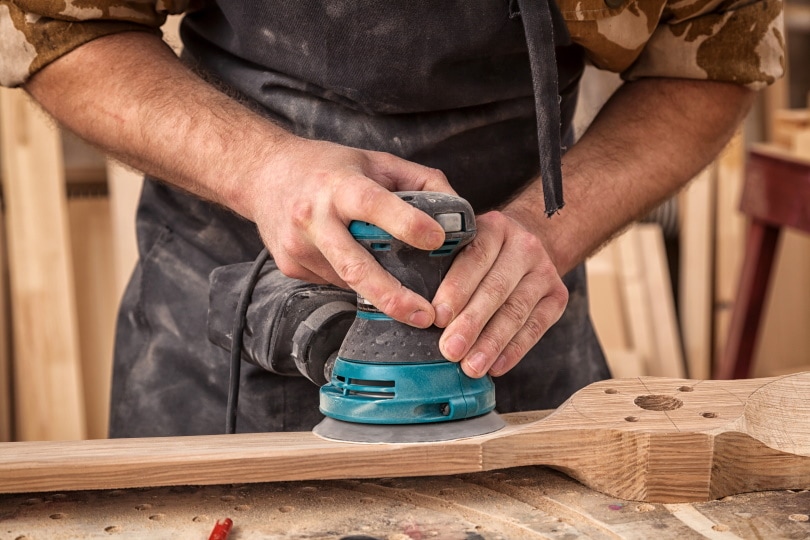Drum Sander vs Orbital Sander: Pros, Cons & Differences
-
Pete Ortiz
- Last updated:

If you have looked into refinishing your floors on your own, you will likely have run into a common conundrum. Should you use a drum sander or an orbital sander? This is a question that comes up time and time again. There are proponents of both who advocate heavily for the use of each. Some people say drum sanders are risky because of their potential to damage your floors. Others say that orbital sanders just won’t cut it when it comes to a professional-grade refinishing job. But which side is correct? What type of sander should you use on your floors?
This overview will dive into both drum sanders and orbital sanders, including the key differences, pros and cons, and frequently asked questions. By the end, you should have a good idea of which type of sander is right for you and your individual floor project.
Click Below to Jump Ahead:
Overview of Drum Sanders

Drum sanders are large and heavy pieces of equipment. These machines sand the floors by using a large spinning drum with sandpaper attached. The drums have a lot of downforce and only make contact with the floor in a very small surface area. The combination of weight and limited surface area creates a very powerful tool that will quickly strip the top layer of a floor. Drum sanders are often the primary choice for general contractors and flooring professionals. In adept hands, drum sanders can make short work out of a large floor with extremely consistent results.
The power and weight of a drum sander can put off some do-it-yourselfers. If you linger too long on one spot on the floor, you can quickly wear through the top layer and into the core of the floor, which can be very bad. The risks associated with damage make some people wary of using drum sanders if they have zero experience with refinishing flooring. Drum sanders also struggle to work in small areas, tight corners, or along borders that feature different grain directions or wood types.
How Drum Sanders Work
Drum sanders work by applying pressure to a small area of the floor. The drum spins at a high rate of speed, and the attached sandpaper wears away the top layer of flooring very quickly. There are three main types of drum sanders, including clamp bar, expandable, and cam lock. The different types of sanders refer to the way that the sandpaper is attached to the spinning drum.
Clamp Bar
Clamp bar sanders use a clamp to hold the sandpaper in place. The clamp is screwed tightly into place over the top of the sandpaper. Clamp bar drum sanders are the most commonly used drum sander on the market. They are simple to operate, and it is easy to change the paper out on the fly.
Expandable
Expandable drum sanders are becoming more popular as the technology gets better. Expandable drum sanders work by sliding a sleeve of sandpaper over the drum. While in operation, the centrifugal force of the spinning drum holds the paper in place. These sanders are often more forgiving and easier to use by less experienced people, but the paper is far more expensive than sandpaper made for a clamp bar sander.
Cam Lock
Cam lock sanders are the oldest and most complicated type of drum sander on the market. It requires the use of a cam lock to hold the sandpaper in place. The cam locks need specific wrenches to tighten and unlock the sandpaper. Cam lock drum sanders are often found in older collections of home improvement tools, and they are not frequently found new or rented out to regular DIY homeowners.
When to Choose a Drum Sander
Drum sanders are great for old floors that have a lot of varnish, warping, or multiple layers of coating. When floors are refinished multiple times, they can get a build-up of old coatings and finishings that hamper your ability to get down to the actual wood to smooth them out. Drum sanders are powerful enough to eat through this upper layer of finishes in mere minutes. Drum sanders are also great for old floors that have started to bend or warp. The drum sander is powerful enough to take the top layer of wood off of the floors, which will leave them smoother and more level than before.
Choose a drum sander if you run into any of the following:
- Old floors with thick topcoats
- Warped floors
- Floors that need to be releveled.
- Very powerful
- Can do large floors very quickly
- Extremely effective at smoothing and leveling
- Can easily handle old floors that look rough
- Extremely heavy
- Hard to operate for inexperienced people
- Can damage your floors
- Not great in tight spaces
Overview of Orbital Sanders

Orbital sanders are a type of sander that uses a rotating motion to sand the floors. Orbital sanders make contact with floors with a large surface area which reduces the pressure on the floors. Orbital sanders are more forgiving but less powerful than drum sanders. The orbital sander gets its name from the motion of the machine, which is a circular orbital pattern. The sanding pattern of an orbital sander is light and random, which means you do not have to follow specific grain patterns or plank directions.
Orbital sanders are much slower at sanding than drum sanders. They are not powerful enough to reduce warping or cupping, and they are often not strong enough to really cut through a thick layer of varnish. That does, however, mean that the orbital sander has much less potential to damage your floors than a drum sander.
How Orbital Sanders Work
Orbital sanders use large flat pieces of sandpaper that oscillate in a circular pattern. Orbital sanders are lighter and easier to manage than drum sanders. The floors get sanded by this circular motion, and the pressure applied to the floor is about 2lbs per square inch over a large area. Orbital sanders are more closely related to a grinder than a drum sander. Grinders use the same spinning motion to reduce thin layers of surface material over a wide area.

When to Choose an Orbital Sander
Orbital sanders are great for many scenarios. They are excellent for newer floors being refinished for the first time. They are a great choice for people who do not have a lot of experience with DIY projects or home improvement. They are good for reaching tight areas or for floors that have a lot of diverging grain patterns that would frustrate a drum sander. Orbital sanders are also great for people who are worried about damaging their floors, whether they are newer floors that you don’t want to replace or original hardwoods that you are worried about damaging.
- Very easy to use and maneuver
- Cannot damage floors
- Great for beginners or inexperienced homeowners
- Cheap to rent, buy and operate
- Very slow results
- Cannot handle thick topcoats
- Cannot relevel floors or eliminate warps or cupping
Frequently Asked Questions
Main Differences Between Drum Sanders and Orbital Sanders
The two main differences between a drum sander and an orbital sander are the sanding motion and the power. Imagine that the sanders are a butter knife, and your floors are a bagel. The drum sander cuts through the floor’s upper layers as if you were sawing through a bagel with a butter knife. You are using a much smaller surface area (the edge) and a more forceful motion. The orbital sander works more like if you spread cream cheese on the bagel with the flat of the blade. Cutting downwards has more power and heft but also more risk of cutting yourself or ripping the bagel. Spreading cream cheese is a simple and safe motion, but it will not be able to cut the bagel in half. That illustration highlights the key differences between drum sanders and orbital sanders in a nutshell.
Do You Need to Be Experienced to Use a Drum Sander?
Ideally, yes. Drum sanders work best in the hands of an experienced operator. Inexperienced users will not get a smooth and even finish. Confident people can give drum sanders a go, and if they use attention to detail and a steady hand, they will be fine. But drum sanders require more patience and more knowledge than an orbital sander. Everyone has to start somewhere, but for the best results, drum sanders should be used by people who know what they are doing.
Which Sander Is Easier to Use?
Orbital sanders. Orbital sanders are lighter, more forgiving, and less complicated than drum sanders. They are easier to change the sandpaper on, maneuver better in tight spaces, and have less risk of a damaging accident. The main tradeoffs for ease of use are power and speed. Doing a large floor with an orbital sander will take far longer than if you were to use a drum sander.
Can Drum Sanders Really Damage Your Floors?
Yes. On high power, if you dally too long in one spot with a drum sander, it will quickly eat through the top protective layer of the floor and start cutting into the sensitive core. If you stop to check your phone with a drum sander running at full blast, you can easily wear a hole in your floor. If you wait too long in one spot, the drum sander can damage a floor to the point where the area would need to be replaced. Once you wear too far into the flooring, it can no longer be refinished or repaired. Drum sanders require your full attention and awareness of when to back down the speed or cut the power to the drum in order to avoid mistakes that could lead to lasting damage.
In Conclusion
The choice between a drum sander and an orbital sander will come down to three key factors, experience, the condition of the floors, and the timeframe. Experienced people working on old floors in a short amount of time can easily choose a drum sander. Inexperienced homeowners with new floors who are looking to learn and refinish them at their own pace will definitely want to choose an orbital sander. The ultimate decision will come down to your individual experience, confidence, floors, timeframe, and budget.
Featured Image Credit: (L) JHawk455, Shutterstock | (R) evgengerasimovich, Shutterstock
Contents


